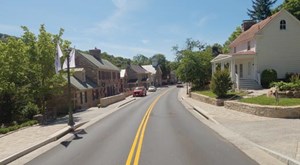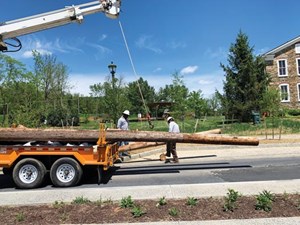October 2021 Vol. 76 No. 10
Features
Tiny Town Raises Funds, Manages Utility Overhaul
By Jeff Griffin, Senior Editor
Last summer, several hundred people gathered in the small town of Hillsboro, Va., for a celebration. The number of people attending the event exceeded, by several times, Hillsboro’s population of 143.
The event in Hillsboro was a ribbon-cutting ceremony for the completion of ReThink 9, and a multi-project undertaking that not only included an improved segment of State Highway 9 – the Charles Town Pike – and Hillsboro’s main street, but replacing overhead lines underground, and constructing a new water system and the town’s first sanitary sewer system (homes and businesses previously relied on septic tanks).
That a very small town was able to envision and complete a project of this magnitude is impressive. A newspaper article called Hillsboro’s achievement a case study for rural success.
“The project,” said Mayor Roger Vance, “was conceived nearly 20 years ago as a traffic-calming and pedestrian safety project, with early study and preliminary design funded by a $1.5-million Federal Highway Administration demonstration grant.
“Funding for concurrent drinking water and wastewater studies and preliminary engineering came from state and county grants. By 2016, the town had amassed nearly $10 million across all of the projects.”
However, with little prospect for state highway funding, the town assumed full administration and management of the project, launched a campaign to “Build it Now, Build it Once” and focused on raising local funds.
“Ultimately,” Vance said, “the town received another $24 million in grants from Loudoun County and the Northern Virginia Transportation Authority, and the town issued its first-ever bonds to fully fund the entire $34-million multi-faceted road and infrastructure project, which broke ground in March 2020 and was substantially completed in May 2021.”
Saving money
Combining the projects into one, implementing a maintenance of traffic plan that included an extensive, complete road closure, and with Hillsboro’s mayor and Vice Mayor Amy Marasco acting as pro-bono project managers, the project cost was reduced by an estimated $7 to $11 million.
Established in 1752, Hillsboro today is considered one of the best-preserved 18th-century villages in the state. Of Hillsboro’s 50 structures, 40 are residences and many are historically significant. Therefore, meticulous care had to be taken during construction to protect historic structures and to preserve, and even enhance, the town’s natural environment.
Mayor Vance told the assembled crowd at the June ceremony that the combined projects were completed on or ahead of schedule and on budget, thanks to the extraordinary cooperation and support from the community, project partners and contractors.
Hillsboro, in the heart of Virginia’s wine country, in Loudoun County – an active agribusiness and tourism area – and the improvements to Route 9 (Charles Town Pike) were key elements in the multiple enhancements. However, the underground utility construction projects for this tiny village were equally impressive.
Engineering consultant Volkert designed the project and managed its construction. Volkert’s chief inspector, Jeffrey (Jazzy) Shanks, was on project sites every day, from the start of the project until completion. According to Shanks, the utility construction elements included:
- Extensive utility work: relocation, undergrounding and upgrading of existing utilities (water, electric, telephone)
- Building of completely new storm sewer and wastewater systems
- Installing town-owned communications underground conduit, a new town-owned street-lighting system, new walking paths and numerous ergonomic improvements.
Dry utilities
Electricity is provided by Dominion Energy and telephone by Verizon. As part of the project, the aerial electric lines were buried deep underground in concrete encased duct banks, linked together by massive electrical vaults/manholes for distribution to each home.
Placed atop the Dominion electric duct banks is an array of Verizon copper and fiber conduit, and a town-owned fiber optic conduit, with hand holes and distribution boxes along the route. The town currently is negotiating for broadband fiber internet service. The town-owned street light conduit system was built separately, largely under the new sidewalk system.
The dry utilities were meticulously designed, in close collaboration, by Dominion, Verizon and the town’s engineering design/construction management firm Volkert; and constructed by the highway project contractor, Archer Western.
The homes were extremely close to the major roadway that went through town and communication on all levels was conducted daily among the team to give each property owner a sense of trust that individual needs came first.
Electric, telephone and fiber-optic conduit trunklines were installed in the same trench and, where achievable, the service laterals and service to homes were likewise combined in common trench.
Because of the historic nature of the homes and the aged infrastructure in place, nearly a dozen in-home service panels required replacement, retrofitting or repositioning to accept the underground electric service.
The town organized and hired an electrician to complete this work, which had to be carefully coordinated with Dominion and the construction contractor.
Collaboration and close communication between the town and its contractor, Dominion and Verizon was essential, especially in the coordination of switchover of service and the subsequent removal of all overhead cables and removal of all utility poles. This level of coordination and accommodation resulted in significant savings in costs and time, ultimately critical to the project’s overall on-time, on-budget performance.
Wet utilities
This project included replacing the entire Hillsboro waterworks distribution mains and laterals, completing a new well water source and new storage facilities, and upgrading the waterworks plant.
Shirley Construction built the new water well. The storage facilities and waterworks, as water distribution systems, were included in the road project contract and built by Archer Western.
When the new water source was brought online, it ended a more than two-decade Boil Water Notice and Consent Order for the town. Previously, the old system’s water source was a spring, for about 200 years.
Also included in the road project was the installation of a low-pressure force main wastewater collection system and laterals to each property.
The town has no existing wastewater system; all [homes and building] have their own private septic systems, including a number of pump and haul locations and cesspools. Project scope was expanded to extend both water and wastewater mains to reach all homes beyond the Route 9 corridor and the next phase of the project will be the installation of a town-owned wastewater treatment plant for the mains to connect to.
All private septic tanks will be decommissioned and removed, and existing drain fields abandoned. This work is anticipated for completion by spring 2022.
The road project also included an extensive and complete underground stormwater collection system that extends the entire length of the project.
Previously, only a rudimentary stormwater management system of ditches and culverts existed, which was inadequate to handle heavy storm flow. Curbs, gutters and dozens of stormwater drain inlets now collect water from the roadway to outfalls draining into the Catoctin Creek on the south edge of town.
Service lines were primarily trenched. However, because of the sensitive historic nature of all the homes – many with historic stone walls in front of them along the roadway – some directional drilling under walls was required. The service line trenching work required meticulous planning and careful excavation, in light of the tight constraints imposed by the historical features and the multiple utilities stacked within the narrow corridor.
Careful consideration
Construction planning and execution had to take into account the fragile condition of the historical homes and their foundations.
A property-by-property plan was established with close collaboration led by the town among property owners, utility engineers (Volkert), and the construction contractor (Archer Western) and its sub-contractors. Weekly progress meetings were held, often including the utilities, and daily communication and consultations were overseen by the town as project owner.
On typical projects, the contractor would utilize larger excavators to dig deep trenches, but due to the space constraints, small low-frequency compactors were used to minimize vibration to protect the home’s foundations.
Use of smaller equipment allowed crews to keep affected areas confined to a smaller footprint while installing service conduits to each home. This allowed restoration efforts to be precise and eliminate any potential damage to historical homes’ foundations.
Extra care had to be taken with boring. Instead of directional boring equipment, the team chose to go with smaller mole/pneumatic piercing tools to go under walls or newly installed pipes.
An elaborate and exhaustive vibration monitoring regime was followed, with thousands of pre- and post-project photos and measurements taken to determine any vibration impacts on structures.
The town established its own process for evaluating the project’s unanticipated physical impacts to properties and for their remediation. Great care was taken in all new construction sensitive to its immediate context – matching new stone wall construction in style, color and texture of mortar work to immediately adjacent existing historic features.
Reflecting on the project, Mayor Vance said the success of ReThink 9 centered on the trust and cooperation of all parties concerned in planning and construction. In addition to the Town of Hillsboro, Volkert, and Archer Western, the team comprised CES Consulting and numerous subcontractors, many of them from the area in and around Hillsboro.
FOR MORE INFORMATION:
Volkert, (251) 342-1070, volkert.com
Archer Western, (404)495-8700, walshgroup.com
CES Consulting, (571) 933-8476, ces-consultingllc.com
LEFT: Ongoing construction in a neighborhood.
ABOVE: Ongoing construction in a neighborhood. Finished Highway 9
Removing one of the utility poles after cable was placed underground.






Comments